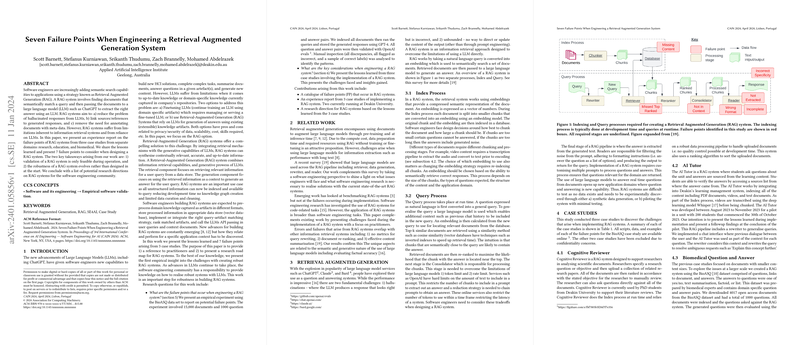Introduction
In light of the evolution of LLMs and their integration into various applications, the use of Retrieval-Augmented Generation (RAG) systems has become increasingly significant. RAG systems are designed to augment the capabilities of LLMs by incorporating a retrieval component that sources relevant documents in response to queries. These systems are instrumental in overcoming challenges associated with directly utilizing LLMs, such as the production of hallucinated content and the difficulty in updating the knowledge base that these models draw from. This paper explores the specific engineering challenges encountered in RAG system implementation across three distinct domains.
Failure Points in RAG Systems
The authors of the paper outline seven critical failure points discovered through empirical experimentation utilizing the BioASQ dataset, consisting of 15,000 documents and 1,000 question and answer pairs. Among these failure points are issues related to missing content where the system fails to provide answers due to the absence of sufficient documents, and ranking errors where relevant documents are not surfaced effectively. Other highlighted failure modes include consolidation strategy limitations, difficulties in extracting the correct answers from provided context, incorrect response formatting, specificity issues, and problems with incomplete answers. Accurate identification and resolution of these failure points are crucial for the reliable operation of RAG systems in practical settings.
Case Studies and Practical Observations
Besides theoretical and empirical insights, the paper chronicles key lessons from three case studies within research, education, and biomedical domains. For instance, the Cognitive Reviewer assists researchers in scientific document analysis by ranking papers according to the research objective. The AI Tutor, integrated within a learning management system, indexes various materials to provide students with contextually accurate answers. The BioASQ case paper, operating at a larger scale with biomedical documents, reinforces the importance of meticulous inspection and the limitations of automated evaluation methods. These practical applications provide a rich experience report which is invaluable to practitioners in this space.
Looking Forward: Recommendations and Research Areas
The paper culminates with pertinent lessons for the future engineering of RAG systems supported by an extensive review of key learnings across the case studies. It underscores the need for ongoing system calibration to address the dynamic nature of input data and system interaction in real-life scenarios. Additionally, it lays out future research directions that hold promise in improving the robustness and efficiency of the RAG systems. These include exploring optimal chunking techniques for documents, investigating the trade-offs between RAG systems, and fine-tuning LLMs, as well as the development of software testing and monitoring practices tailored to RAG system specifications.
In essence, this paper serves as a comprehensive experience report on engineering RAG systems, offering both a practitioner's guide and a research roadmap. It shines a light on the intricacies of implementing RAG systems and paves the way for subsequent advancements in the field.
